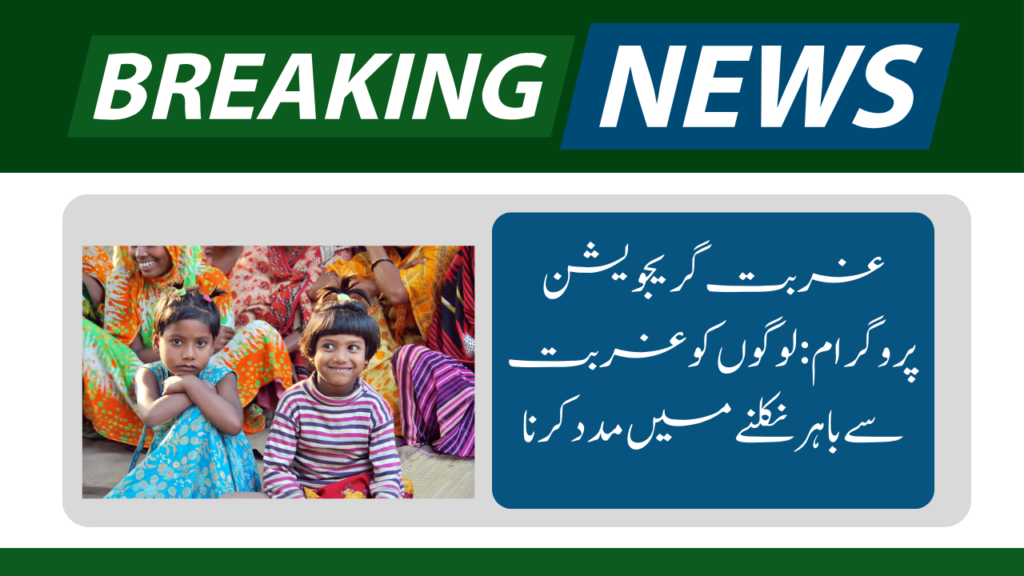
Poverty Graduation Program
The Government’s Poverty Graduation Program is a remarkable initiative aimed at transforming the lives of the very poor by equipping them with the resources and skills needed to become self-sufficient. This program stands as a beacon of hope for countless individuals and families striving to break free from the chains of poverty. But what exactly does this program in detail, and how does it work? Let’s dive deep into the various facets of this life-changing project.
Poverty Graduation
Poverty graduation refers to the process of enabling individuals to move from extreme poverty to a state of self-reliance. The primary objective of this program is to alleviate poverty by providing underprivileged people with the necessary resources and opportunities to sustain themselves. It’s about empowering people to create a stable and independent future for themselves and their families. The program targets the most vulnerable and impoverished segments of society. These are individuals and families who lack the means to improve their living conditions due to limited access to resources, education, and economic opportunities.
Key Components of the Program
One of the fundamental elements of the Poverty Graduation Program is the provision of cash grants. These grants are designed to help individuals kickstart or enhance their small businesses. The financial boost provided by these grants can be the key to unlocking new opportunities for many. In addition to financial support, the program offers extensive training in various trades. This training aims to enhance employability and business efficiency, ensuring that beneficiaries have the skills needed to succeed in their chosen fields. To further support business growth, the program provides low-interest or interest-free loans. These loans are crucial for scaling up operations and increasing income, allowing small enterprises to thrive and expand.
How the Program Works
Applying for the Poverty Graduation Program involves a series of steps designed to ensure that support is given to those who need it most. Applicants typically need to demonstrate their financial need and potential for business development.
Initial Assessment: Potential beneficiaries are assessed to determine their eligibility and specific needs.
Resource Allocation: Based on the assessment, suitable resources such as cash grants, training, and loans are allocated.
Implementation: Beneficiaries use the provided resources to start or expand their businesses, with continuous support and guidance from program administrators.
Monitoring: Regular follow-ups ensure that the resources are being used effectively and the beneficiaries are progressing towards self-sufficiency.
Support Provided by the Program
Cash grants are modest sums of money given to individuals to help them start or enhance their existing businesses. This financial assistance is critical for those who do not have adequate funds to invest in their enterprises. The grants can cover various expenses, including purchasing equipment, raw materials, or stock. The program’s training component is diverse and comprehensive. It covers a range of trades and skills, from basic business management to specialized vocational training. This instruction equips beneficiaries with the knowledge and skills needed to run their enterprises more effectively and increase their employability in the job market. In addition to cash grants, the program offers loans designed to support business growth. These loans are often low-interest or interest-free, making them accessible to those who might otherwise be unable to secure financing. The loan amounts and repayment terms are tailored to the individual needs and capacities of the beneficiaries.
Benefits of the Program
The Poverty Graduation Program empowers individuals by providing them with the tools needed to generate their own income. This economic empowerment is a significant step towards self-sufficiency and independence. By enabling people to start and grow their own businesses, the program helps reduce overall poverty rates. Successful enterprises create job opportunities and stimulate local economies, contributing to broader economic growth. Beneficiaries of the program often experience substantial improvements in their living conditions. Increased income allows them to afford better housing, healthcare, and education for their families, leading to a higher quality of life.
Success Stories
The Poverty Graduation Program has numerous success stories. For instance, Maria, a single mother, used her cash grant to start a tailoring business. With the training provided by the program, she honed her skills and now runs a successful enterprise, providing for her children and even hiring others from her community. These individual successes have a ripple effect on families and communities. As beneficiaries become self-sufficient, they contribute to the local economy, create jobs, and serve as role models for others, inspiring a culture of entrepreneurship and self-reliance.

Challenges and Solutions
Despite its successes, the program faces several challenges. These include reaching the most remote and underserved populations, ensuring the sustainability of supported businesses, and addressing the diverse needs of beneficiaries.
To address these challenges, the program adopts various strategies such as:
Partnering with local organizations to extend its reach.
Providing continuous mentorship and support to ensure business sustainability.
Tailoring interventions to the specific needs of different communities.
Comparative Analysis
Other countries have implemented similar poverty graduation programs with varying degrees of success. For example, Bangladesh’s BRAC program has been widely recognized for its comprehensive approach to poverty alleviation. Analyzing these programs provides valuable insights and best practices that can be adapted to enhance the effectiveness of the Poverty Graduation Program. Key lessons include the importance of holistic support, community involvement, and continuous monitoring.
Future Prospects
The government plans to expand the program to reach more individuals and communities. This expansion includes increasing funding, enhancing training modules, and developing new partnerships. Potential improvements to the program include integrating more advanced technology for training and support, developing targeted interventions for different demographics, and increasing the focus on sustainability.
Government and Community Involvement
Government agencies play a crucial role in the implementation and success of the Poverty Graduation Program. They provide the necessary funding, policy support, and administrative oversight to ensure the program’s effectiveness. Community participation is vital for the program’s success. Local leaders, organizations, and beneficiaries themselves contribute to the program’s implementation and continuous improvement.
Sustainability and Long-term Impact
To ensure the long-term benefits of the program, it’s essential to focus on sustainability. This includes providing continuous support, fostering a culture of savings and among investment beneficiaries, and encouraging community-driven development. Regular monitoring and evaluation are critical to assess the program’s impact and make necessary adjustments. This helps in understanding what works, what doesn’t, and how the program can be improved over time.
FAQs
What is the Poverty Graduation Program?
The Poverty Graduation Program is a government initiative aimed at helping poor people become self-sufficient by providing them with cash grants, training, and loans.
How does the program help people?
The program helps people by providing financial assistance, training, and loans to start or improve their small businesses, which helps them earn a steady income.
Who can benefit from the program?
The program is designed for very poor individuals and families who need help to improve their living conditions and become self-sufficient.
What are some success stories from the program?
Many people have started successful small businesses such as shops, tailoring services, and farms, which have helped them earn a decent income and improve their living standards.
How can one apply for the Poverty Graduation Program?
Interested individuals can apply through designated government offices or online portals. They need to demonstrate their financial need and potential for business development.
